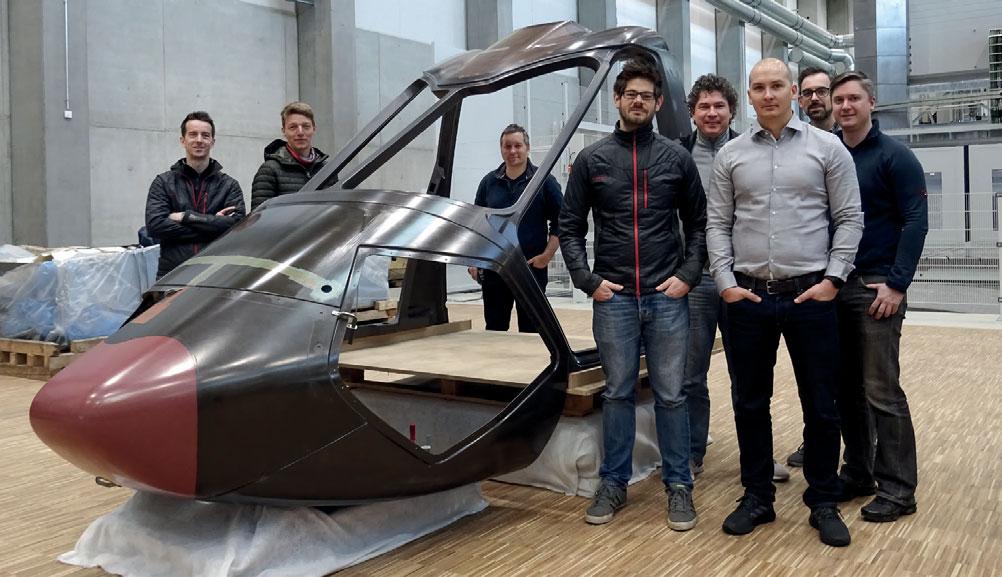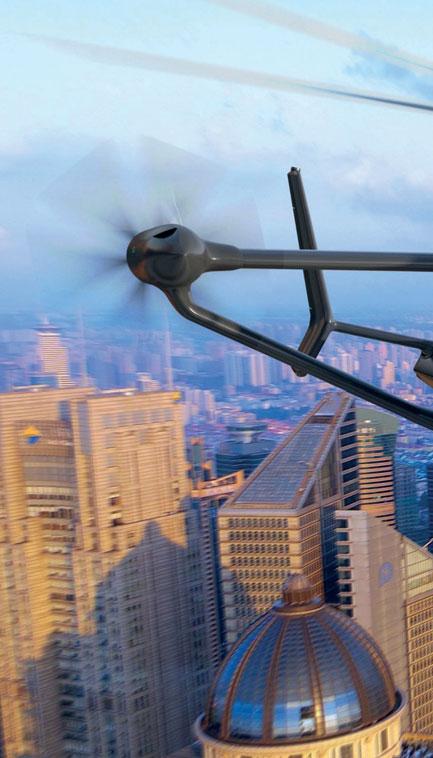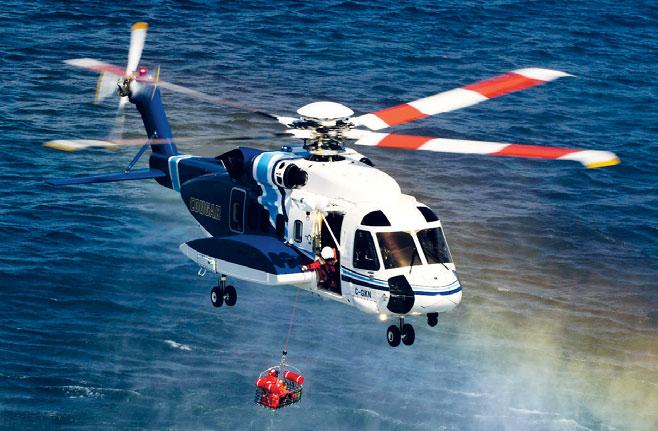
14 minute read
Airbus focuses on maintaining Racer’s pace
DEVELOPMENT DOMINIC PERRY LONDON Airbus Helicopters focuses on maintaining Racer’s pace
Programme partners start building components for high-speed technology demonstrator
Advertisement
First flight may have slipped by around 12 months, but at production sites across Europe, components for the Airbus Helicopters Racer high-speed technology demonstrator are beginning to come together.
In early April, the slender nose of the new helicopter was revealed as the three sub-assem blies making up its canopy were joined into a single structure.
While the development has been relatively untroubled, it has not been without its challenges, and has also required a weight saving drive by the manufacturer.
Clearance for manufacturing was triggered by the conclusion of the critical design review in De cember 2019. Assuming the coronavirus outbreak does not add significant delay to the programme, final assembly should begin by mid-year at Airbus Helicopters’ fa cility in Marignane, France.
“To be precise it is almost all the aircraft which is ready for production but there are some topics that have some delay, although nothing really critical at the moment,” says Brice Makin adjian, Airbus Helicopters’ chief engineer for the Racer.
Part of the EU-funded Clean Sky 2 programme, the Racer – or Rapid and Cost-Effective Rotorcraft, to use its convoluted acronym – should now make its maiden sortie in the fourth quarter of 2021, later than the original 2020 target.
“There are 50 entities that we have to manage to build an aircraft that will fly” Brice Makinadjian
Chief Racer engineer, Airbus Helicopters
The design builds on research conducted with Airbus Helicop ters’ X3 demonstrator in the middle of the last decade, but features V-shaped box wings for additional lift, twin pusher propellers and technology to allow one of the two engines to be idled – and rapidly restarted – during the cruise.
Given the project’s technical and industrial ambitions, it should probably come as little surprise that the timeline has slipped somewhat to the right.
The Clean Sky project seeks to foster innovation and grow com petencies in companies across the continent, all of which means that the development chain for each programme is more com plex than usual.
For the Racer, while Airbus Helicopters is the project lead at the vehicle level, it has 17 core partners and 35 other partners in the effort. Crucially, none of these are selected by the airframer but by the Clean Sky joint undertaking following an open call process.
Some are more familiar with it than others, such as long-time propulsion partner Safran Helicopter Engines, which is supplying twin Aneto-1X powerplants for the technology demonstrator.
There are also consortia of industry and research bodies or academia: Romaero and Romania’s INCAS aerospace institute are building the fuselage, while Mag naghi Aeronautica and Italian
FastCan/Airbus Helicopters Motorsport specialist consortium has designed rotorcraft’s canopy, with structure completed in April

aerospace council CIRA are developing the landing gear.
And at the other extreme come businesses never previously involved in aerospace, such as German automotive specialists KLK Motorsport and Modell und Formenbau Blasius Gerg, which have teamed as the FastCan con sortium to produce the Racer’s lightweight canopy.
The time and effort required to manage a group of this size is largely the reason for the programme’s delay, admits Makinadjian.
“There are 50 entities that we have to manage in order to build an aircraft that will fly. This brings a bit of complexity in terms of management and it is probably slowing down a little bit the way we can develop,” he says.
PROJECT COMPLEXITIES
His comments are echoed by Antonello Marino, project officer for the Fast Rotorcraft Innovative Aircraft Demonstrator Platform within the Clean Sky programme. “The major challenge is that it is a programme that is built in a way that is co-ordinated by the leader but receives contributions from a number of complementary grants and partners,” he says.
“That means that a very minor delay at one level may affect the overall plan of the Racer.”
While the majority of the Racer is on track, development of the new gearbox is running late, admits Makinadjian. He stresses that this is not due to “technical issues” but simply trying to align its methodologies with those of co-developer Avio Aero.
“There are many discussions made between specialists to un derstand each other. Especially in the field of the main gearbox these are taking a bit longer than for other designs,” he says.
But Makinadjian is at pains to point out that the lateral driveline, a key part of the new transmission, remains on schedule.
Comprising flexible shafts rotating at 3,000rpm, the drivelines transfer power from the main gearbox down the wings to the lateral gearboxes in order to drive the pusher propellers.
Makinadjian says endurance tests of a flight-representative example of the component are ongoing. “We have already produced the shaft – this is a real achievement,” he adds.
When developing the X3, Airbus Helicopters re-used compo

nents from other aircraft in its range, such as the fuselage from an AS365 Dauphin.
But Makinadjian says the level of re-use is dramatically lower on the Racer: around 10% of the gearbox components are from previous designs and certain elements of the avionics are drawn from existing helicopters, but the rest is entirely new.
Although for its first flight the Racer will be fitted with a main rotor from an H175 supermedium-twin, Airbus Helicopters intends to swap the blades for those with an “optimised” design.
The new blades are being developed as part of a French-funded research project and will not be ready in time for the maiden sortie. While he declines to elaborate on the shape of the new blades, Makinadjian says the “evolution” will take into account “all the experiences we have on the X3 and the design of the Racer.”
One additional capability will also not be used during the early stages of testing: the stop-start function on the Aneto-1X engines.
Explaining the decision, Makinadjian stresses that although the Racer’s development has been informed by the X3 effort, it is “quite
Manufacturer will assess suitability for a variety of civil missions
Airbus Helicopters
a new formula” and as such “we have to take it step by step”.
“Before stopping one engine in flight and having only one re maining I would like to demonstrate the Racer’s formula and the way it is behaving first,” he says.
“We have to measure the formula and every detail of how it is behaving and then introduce any major modification. I am more comfortable if every other parameter is measured and we only have the one to test.”
In addition, budget and resource limitations are also pushing the programme towards sequential rather than parallel testing, he says.
The Racer will have a maxi mum take-off weight of about 7-8t. The conventional H160 being developed by Airbus Helicopters carries 12 passengers but is 2t lighter. But the difference in their respective maximum cruise speeds is pronounced: 220kt (407km/h) versus 155kt.
Speed, as Makinadjian points out, comes at a cost; the addition of the box wing, propellers and specific canopy all add weight to the structure. To achieve the target 220kt cruise speed and have the same weight and capacity as the H160 “is not feasible”.
Managing the Racer’s mass is such a crucial factor that Marino says during the design phase, Airbus Helicopters “was obliged to launch a sort of weight saving campaign, bringing that closer to the original target.”
MATERIAL DIFFERENCE
This has been achieved through the use of innovative materials and manufacturing processes, he says. For example, the composite-reinforced canopy is some 7% lighter than the original design requirements.
In addition, the “very, very innovative” tail structure, produced by Aernnova of Spain, uses for the first time “very light” primary structural components produced via additive layer manufacturing, alongside external parts made through resin-transfer moulding.
Similar efforts across the helicopter have resulted in an acceptable overall weight for a technology demonstrator, says Marino.
Key aims for the roughly 200h of flight testing planned, lasting around two years, will be to validate the Racer’s performance against the Clean Sky goals – a 220kt cruise speed but with 20% lower emissions of carbon dioxide, nitrogen oxides and noise than current helicopters.
But the airframer will also use the flight-test phase to give “con crete demonstrations” of the helicopter’s utility for current civil and parapublic missions: increasing the area that can be covered during search and rescue operations or cutting the time required for emergency medical services.
Although the Clean Sky programme restricts the development to technology readiness level 6, short of full industrialisation, the mission demonstrations are clearly aimed at gauging the market potential of the technology.
While he stresses it is his opin ion, not that of the company, Makinadjian believes that by the middle of the decade Airbus Helicopters will be in a position to see if it makes sense to launch a commer cial development programme.
“In five years from now we will definitely have all the parameters to take decisions,” he says. ■
DEVELOPMENT KATE SARSFIELD LONDON Equator charges up electric ambitions
Start-up seeks funds to launch production of four-seat battery-powered floatplane, with larger version planned by 2030
Norwegian start-up Equator
Aircraft is developing a small family of all-electric amphibians to provide what it describes as “a sustainable alternative” to the established types now serving the owner-flyer and commercial passenger transport markets.
Based at Jarlsberg airport 60 miles (100km) south of Oslo, the company began flight testing a proof-of-concept, all-composite two-seat aircraft in 2018.
Feedback from these trials is being incorporated into the first production-conforming prototype – a stretched version of the con cept aircraft called the X4, designed to seat up to four occupants. Preliminary design work is also under way on an eight-seat model, which Equator hopes to market by the end of the decade.
The concept aircraft uses a 100kW tail-mounted electric motor, supplied by German company Engiro, which is powered by a 12kWh battery in the cabin and a 6kWh one in the nose. It has reached a top speed of 100kt (185km/h), and a maximum endurance of 35min.
The X4 will feature a 75kWh lithium-ion battery pack powering a 120kW electric motor to give a range of up to 270nm (550km).
Equator is seeking around €5 million ($5.4 million) to bring the X4 to market. Chief executive Tomas Brodreskift says this investment will also provide sufficient working capital to launch planned sales and marketing initiatives and to accelerate production. “Our plan is to launch flight testing of the first productionconforming X4 within 18 months,” says Brodreskift.
To expedite the X4’s entry into service, Equator will seek certification from the Norwegian civil aviation authority under experi mental regulations. “This should take around 40h of flight testing, and allow us to begin delivering aircraft to local customers who just want to fly for pleasure,” Brodreskift says.
Feedback from these owners will assist Equator with the X4’s European Union Aviation Safety Agency CS-23 certification cam paign, with final approval scheduled for 2025.
European validation will open up a much larger market for the X4, both geographically and op erationally, with the aircraft an
Manufacturer began flight testing proof-of-concept aircraft in 2018

ideal platform for short hops be tween islands and towns, as well as sightseeing operations. The X4 will compete against long-standing models in this segment such as the float-equipped Cessna 172 and 182 piston-singles.
Equator hopes to introduce the eight-seat amphibian by 2030, with the aircraft targeted at the commercial passenger transport market.
Brodreskift says this segment is dominated by float-equipped, single-engined aircraft such as the Cessna 206/208 Caravan, Daher Kodiak 100 and de Havilland Canada DHC-2 Beaver, “which are noisy, expensive and costly to maintain”.
Avinode has launched a dedicated emergency assistance platform, driven by the increase in demand for air ambulance and humanitarian flights following the coronavirus outbreak.
INITIATIVE KATE SARSFIELD LONDON Avinode unveils online emergency relief platform
Online charter marketplace
The platform, called Avinode
“Our all-electric commercial seaplane will be extremely quiet, emission-free with very low operating and maintenance costs,” he adds.
Many of the world’s major towns and cities are located near water, says Brodreskift, making downtown-to-downtown routes using seaplanes very attractive.
Equator is collaborating with Danish operator Nordic Seaplanes to create the “ideal platform” for this segment. Nordic currently operates a single DHC-6-300 Twin Otter for scheduled, sightseeing and ad hoc charter services, but is keen to offer an all-electric aircraft fleet, says Brodreskift. ■

Hummingbird Aviation Services
Aid, is described by the Swedish company as a “goodwill initiative”, which utilises Avinode technology “to assist the aviation community in its relief efforts during the Covid-19 pandemic”.
Avinode Aid allows all operators to place available ambulance aircraft and helicopters on the Avinode platform for free, whether or not they are members of the online marketplace.
Avinode executive vicepresident Per Marthinsson says it is “critical” for the business aviation charter community to collaborate during this pandemic, “to find ways to bring special-mission aircraft to those in need”.
He describes technology as “an enabler of this collaboration”, which will initially run until the end of the year. “We are hopeful that by providing Avinode Aid as a free service for operators, we will connect brokers with the ambulance aircraft their customers need for medical transportation and humanitarian relief,” says Marthinsson. ■
AFTERMARKET KATE SARSFIELD LONDON Textron offers finance for Citation enhancements
Textron Aviation has unveiled a finance programme to help Citation business jet owners in the USA fund aftermarket modifications during the lull in travel due to the coronavirus outbreak.
Backed by the company’s finance division, the initiative is intended to spread the cost burden of interior refurbishments, and modifications such as flightdeck and in-flight connectivity upgrades. It will also drive business to Textron Aviation’s 11 Citation service centres in the USA.
“This new programme offers customers a path to completing aftermarket modifications or up grades on a timeline that is best for them and their business,” says Textron Aviation.
ORDER DOMINIC PERRY LONDON Cougar Helicopters pounces on Sikorsky S-92 upgrade kit

Textron Aviation Company is seeking to help customers utilise unexpected downtime
Key elements of the upgrade include a new main gearbox with increased run-dry capability and an increase to the maximum takeoff weight (MTOW) from 12,000kg (26,500lb) to 12,250kg.
Sikorsky is also incorporating the modifications into new-build S-92 helicopters as the B-model variant. Along with the MTOW increase and new gearbox, the more powerful -8A6 version of the type’s GE Aviation CT7 en gines is also available, together with avionics improvements.
“The S-92A+ and S-92B programmes demonstrate Lockheed Martin’s commitment to the commercial business and to our customers,” says Sikorsky commercial systems and services vice-president Audrey Brady.
“This programme will enhance safety and lower operating
Airframer wins launch customer for enhanced gearbox and weight increase to rotorcraft
Sikorsky has secured a launch order for its S-92A+ upgrade kit, with Canada’s VIH Aviation Group signing a four-unit agreement for the fleet of its operating division Cougar Helicopters.
“Some customers are using downtime as a result of Covid-19 to complete upgrade projects that they have been considering or planning for a different time.”
Textron says the programme is available to “most” of the 5,000 US-registered Citation fleet, although it will not be drawn on which models are excluded.
The company also will not dis close whether it plans to roll out the programme globally. ■
Firm has operated type since 2004
costs, and we are honoured to work with VIH as our launch customer,” he adds.
VIH says it is “pleased” to be the lead customer for the S-92A+ kit, which will improve the fleet’s “performance and capacity”.
Sikorsky anticipates that the S-92A+ upgrade kit will be delivered by 2023, and the S-92B helicopter in 2025.
Cougar Helicopters, which is 40%-owned by Bristow Group,
Sikorsky

has been operating the Sikorsky type since 2004.
Cougar also has the unfortunate distinction of being involved in the biggest loss of life involving the type, when an S-92 on an offshore crew-change mission ditched and sank off Newfoundland in 2009, following the loss of oil pressure in the main gearbox. Seventeen of the 18 passengers and crew aboard died in the accident. ■
RELOCATION JON HEMMERDINGER BOSTON Aerion shifting headquarters to new Florida site
Aerion Supersonic is relocating from Reno, Nevada, to a new $300 million campus in Melbourne, Florida, in the heart of the state’s aerospace cluster.
The facility, dubbed Aerion Park, will house the company's global headquarters and integrated campus for research, design, build, and maintenance of the AS2 supersonic business jet.
Aerion plans to break ground on the campus later this year, with manufacturing of the AS2 anticipated to start in 2023.
The company expects Aerion Park to attract “key aerospace suppliers… creating roles for scientists, designers, engineers and aircraft builders”. Melbourne has a number of companies in its aerospace cluster including Collins Aerospace, Embraer Executive Jets and L3Harris Technologies.
Powered by GE Aviation Affinity engines, the AS2 will cruise at Mach 1.4, making it capable of flying between New York and Cape Town in 9h 56min – 3h 39min less than “standard flights”, the company says. ■



